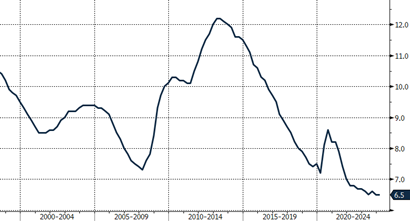
Rate Hikes, Dovish Twists: The Fed and BoE – Balancing Inflation and Growth
15 May 2024
The 2024 US Economic Rollercoaster: Inflation, Rates, and Geopolitical Tensions Take Hold
28 May 2024RISK INSIGHT • 22 MAY 2024
ECB on a Tightrope: Will It Cut Rates?

Marc Cogliatti, Head of Capital Markets - EMEA
In this day and age, expecting the unexpected has been a prudent strategy. The market is pricing in a 97.8% probability that the ECB Governing Council elects to cut rates by 25bps when it meets in two weeks, taking the target rate down to 3.75%. The market foresees another 25bps cut in October and a roughly 50% chance of a third cut in December.
Clearly a cut in June is almost a certainty, but similar to the stance we’ve taken with the Fed and BoE this year, we question whether the ECB will be as dovish going forward as the market is currently expecting.
The case for monetary easing is relatively simple – headline inflation has fallen from over 10% in Q4 2023 to 2.4% in April. Meanwhile, the economy is growing at a lacklustre 0.3% quarter on quarter, following contractions in the latter half of 2023. It goes without saying that all the member states could use a shot of adrenaline to aid growth and stop the economy sliding back into recession in the coming quarters.
However, implementing a series of rate cuts might be more complex, and the ECB faces a delicate balancing act.
- Global inflation: stubborn inflation, particularly in the US and UK, and aggressive rate cuts signalled by the ECB will likely weigh on a currency that is already under pressure. Whilst it will give economic growth a much-needed boost, it will also drive up the cost of imports, potentially leading to higher prices for consumers.
- Wage pressures: Eurozone unemployment remains at its lowest level since the inception of the single currency, suggesting upward pressure on wages. If consumers have more money in their pockets, it allows retailers to push prices up further, as ECB Vice President Luis de Guindos noted last week. His refusal to commit to further rate cuts after June reflects this uncertainty.
Chart 1: Eurozone Unemployment

Source: Bloomberg
- Geopolitical tensions: in both Ukraine and the Middle East, tensions show no signs of abating, and while energy prices remain subdued for now, this could all change very quickly, especially later in the year as winter approaches.
- IMF caution: the IMF has expressed concerns about the risks of aggressive easing. In a recent statement, it highlighted that maintaining current rates might be less disruptive than cutting now and potentially having to raise them again, should it become apparent a mistake has been made.
What does this mean for markets?
There are a few market implications here.
- Hedging for EUR borrowers: first and foremost, current market conditions present an attractive opportunity for those with EUR borrowing to hedge against the risk of higher rates. The two-year swap rate is currently ~3.20% while borrowers are able to lock in 5-year rates at 2.79%. From here, risks feel somewhat asymmetric (i.e. the risk that markets have overestimated the number of cuts outweighs the risk that markets have underestimated how aggressive the ECB are likely to be).
- Potential euro upside: from an FX perspective, if rate cuts aren’t quite so forthcoming, it suggests upside risks to the euro in the months ahead (aligning with our long-held view). Looking at other indicators, both risk reversals and positioning in futures are relatively neutral suggesting that a rally in the euro is far from beyond the realms of possibility.
Be the first to know
Subscribe to our newsletter to receive exclusive Validus Insights and industry updates.

